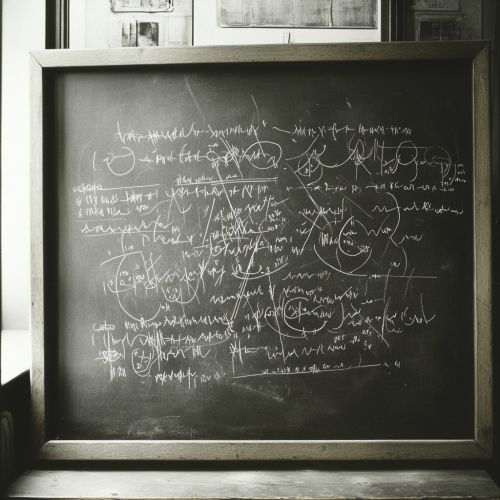Birch and Swinnerton-Dyer conjecture: Difference between revisions
(Created page with "== Introduction == The Birch and Swinnerton-Dyer conjecture is a prominent unsolved problem in number theory, particularly in the field of elliptic curves. It is one of the seven Millennium Prize Problems, for which the Clay Mathematics Institute has offered a prize of one million dollars for a correct solution. The conjecture provides a deep connection between the number of rational points on an elliptic curve and the behavior of an associate...") |
No edit summary |
||
| (One intermediate revision by the same user not shown) | |||
| Line 44: | Line 44: | ||
== Image == | == Image == | ||
[[Image:Detail-104425.jpg|thumb|center|Photograph of a chalkboard with complex mathematical equations related to elliptic curves written on it.|class=only_on_mobile]] | |||
[[Image:Detail-104426.jpg|thumb|center|Photograph of a chalkboard with complex mathematical equations related to elliptic curves written on it.|class=only_on_desktop]] | |||
== See Also == | == See Also == | ||
Latest revision as of 18:08, 18 November 2024
Introduction
The Birch and Swinnerton-Dyer conjecture is a prominent unsolved problem in number theory, particularly in the field of elliptic curves. It is one of the seven Millennium Prize Problems, for which the Clay Mathematics Institute has offered a prize of one million dollars for a correct solution. The conjecture provides a deep connection between the number of rational points on an elliptic curve and the behavior of an associated L-function at a specific point.
Historical Background
The conjecture was formulated in the early 1960s by British mathematicians Bryan Birch and Peter Swinnerton-Dyer. Their work was inspired by extensive numerical calculations performed on the EDSAC computer at the University of Cambridge. These calculations suggested a relationship between the rank of an elliptic curve and the order of the zero of its L-function at s = 1. This observation was later formalized into the conjecture that bears their names.
Elliptic Curves
An elliptic curve is a smooth, projective algebraic curve of genus one, with a specified point defined over a field. In the context of the Birch and Swinnerton-Dyer conjecture, the field of interest is typically the field of rational numbers, \(\mathbb{Q}\). An elliptic curve over \(\mathbb{Q}\) can be expressed in the form:
\[ y^2 = x^3 + ax + b \]
where \(a\) and \(b\) are rational numbers such that the discriminant \(\Delta = 4a^3 + 27b^2 \neq 0\). The set of rational points on an elliptic curve forms a finitely generated abelian group, as established by the Mordell-Weil Theorem.
L-functions and the Conjecture
The L-function associated with an elliptic curve \(E\) over \(\mathbb{Q}\) is a complex analytic function \(L(E, s)\), defined as an Euler product over primes \(p\):
\[ L(E, s) = \prod_{p} \left(1 - a_p p^{-s} + p^{1-2s}\right)^{-1} \]
where \(a_p\) is the number of solutions to the curve modulo \(p\), minus \(p\). The Birch and Swinnerton-Dyer conjecture posits that the rank of the group of rational points on an elliptic curve is equal to the order of the zero of its L-function at \(s = 1\).
The Conjecture's Statement
The conjecture can be divided into two parts:
1. **Weak Form**: The rank of the elliptic curve \(E(\mathbb{Q})\) is equal to the order of vanishing of \(L(E, s)\) at \(s = 1\). 2. **Strong Form**: The leading coefficient of the Taylor series expansion of \(L(E, s)\) at \(s = 1\) is related to several arithmetic invariants of the curve, including the Tamagawa numbers, the regulator of the curve, and the order of the Shafarevich-Tate Group.
Numerical Evidence and Partial Results
Numerical evidence supporting the conjecture was first gathered by Birch and Swinnerton-Dyer through computational experiments. Since then, significant progress has been made in proving special cases of the conjecture. For instance, the conjecture is known to hold for elliptic curves with rank 0 or 1, thanks to the work of Andrew Wiles and others in proving the Modularity Theorem, which was a crucial step in the proof of Fermat's Last Theorem.
The Role of the Shafarevich-Tate Group
The Shafarevich-Tate Group \(\Sha(E/\mathbb{Q})\) of an elliptic curve \(E\) is a mysterious and complex object that measures the failure of the local-global principle for the curve. The Birch and Swinnerton-Dyer conjecture implies that \(\Sha(E/\mathbb{Q})\) is finite, and its order is a key factor in the conjecture's strong form. Understanding \(\Sha(E/\mathbb{Q})\) is one of the major challenges in the study of elliptic curves.
Current Research and Open Problems
Research on the Birch and Swinnerton-Dyer conjecture continues to be a vibrant area of mathematical inquiry. Efforts are focused on understanding the conjecture's implications for higher-rank elliptic curves and exploring its connections with other areas of mathematics, such as Algebraic Geometry and Arithmetic Geometry. Despite significant advances, a complete proof of the conjecture remains elusive.
Image


